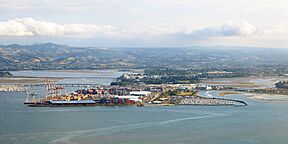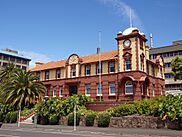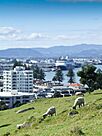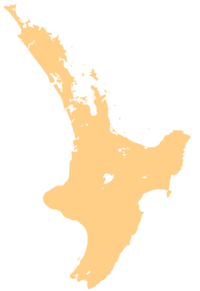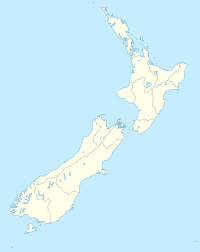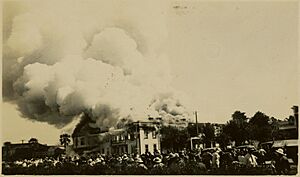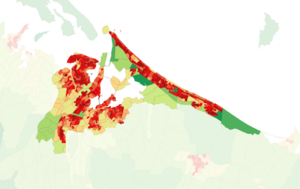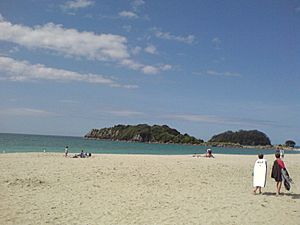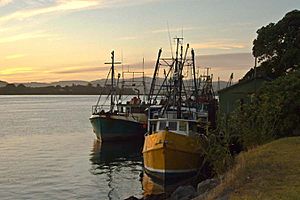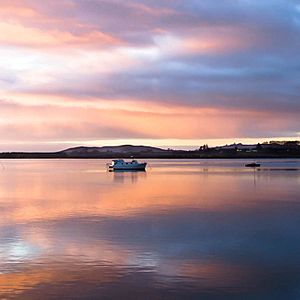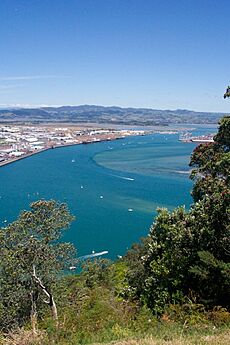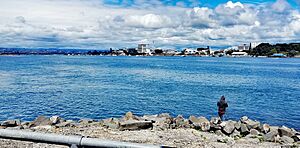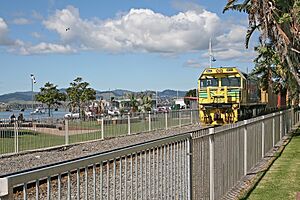Tauranga facts for kids
Quick facts for kids
Tauranga
|
|
|---|---|
|
Tauranga City
Tauranga Post Office
View from the Mount
Historic villas in Tauranga South
Classic Car show taking place at The Strand
|
|
| Country | New Zealand |
| Island | North Island |
| Region | Bay of Plenty |
| Wards | Mauao/Mount Maunganui Matua-Otūmoetai Te Papa Bethlehem Tauriko Welcome Bay Arataki Pāpāmoa Te Awanui (Māori) |
| Settled | 1250–1300 |
| Gazetted as a borough | 1882 |
| City constituted | 17 April 1963 |
| Electorate(s) | Tauranga Bay of Plenty |
| Area | |
| • Land | 141.91 km2 (54.79 sq mi) |
| Highest elevation | 232 m (761 ft) |
| Lowest elevation | 0 m (0 ft) |
| Population
(June 2023)
|
|
| • Territorial | 161,800 |
| • Urban | 161,800 |
| Time zone | UTC+12:00 (NZST) |
| • Summer (DST) | UTC+13:00 (NZDT) |
| Postcode(s) |
Map of postcodes
3110, 3112, 3116, 3118 |
| Area code(s) | 07 |
| Local iwi | Ngāti Ranginui, Ngāi Te Rangi, Ngāti Pūkenga |
| Website | Tauranga.govt.nz |
Tauranga is a lively coastal city in New Zealand's Bay of Plenty Region. It's the fifth-largest city in the country. About 3% of New Zealand's people live here. Māori people first settled Tauranga in the late 1200s. Europeans arrived in the early 1800s. Tauranga officially became a city in 1963.
The city is in the north-western part of the Bay of Plenty. It sits on the south-eastern edge of Tauranga Harbour. Tauranga covers about 142 square kilometers. It includes many communities like Bethlehem, Greerton, Matua, and Mount Maunganui. Papamoa is Tauranga's biggest suburb.
Tauranga is a major center for business and trade in New Zealand. It's also important for culture and growing fruits. The Port of Tauranga is New Zealand's largest port. It handles the most exports and is very efficient. Tauranga is one of New Zealand's fastest-growing cities. Its population grew by 19% between 2013 and 2018. This growth made it the fifth-largest city, passing Dunedin and the Napier-Hastings areas.
Contents
- History of Tauranga
- Geography and Landscape
- City Areas and Suburbs
- Climate and Weather
- Population and Demographics
- Economy and Business
- Arts, Culture, and Events
- Sports and Recreation
- City Attractions and Facilities
- City Infrastructure
- Transportation in Tauranga
- Education in Tauranga
- Notable People from Tauranga
- Sister Cities
- See also
History of Tauranga
Early Settlement
The first people to settle in Tauranga were Māori. They arrived in the 13th century. They came in large canoes called waka, including the Tākitimu and Mātaatua.
The first European ship to enter Tauranga Harbour was the Herald. This happened on June 23, 1826. A Christian service was held at Otamataha Pā. European traders came to the Bay of Plenty in the 1830s. They traded flax for things like muskets. Some of them settled down permanently.
The first permanent non-Māori trader was James Farrow. He bought land in 1838 at Otūmoetai Pā. This was the first known land purchase by a European in the Bay of Plenty. A Catholic mission station opened in 1840. It closed in 1863 because of land wars.
New Zealand Wars: Tauranga Campaign
The Tauranga Campaign was a series of battles. They took place in and around Tauranga in 1864. This was during the New Zealand Wars. The most famous battle was the Battle of Gate Pā.
The Battle of Gate Pā happened on April 29, 1864. British forces attacked a strong Māori fort called a Pā. The British had about 300 soldiers. They suffered heavy losses, with 31 dead and 80 wounded. This was one of their biggest losses in the New Zealand Wars. The Māori defenders left the Pā during the night. About 25 Māori soldiers died.
Major Fires in the City
In November 1916, a big fire destroyed 12 buildings on The Strand. This included the Commercial Hotel.
Another large fire happened in 1936. It started in the hotel's staff area. Many people came to watch the fire.
Modern Development
Tauranga officially became a city again on March 1, 2004. This was under a new government order. In 2011, Tauranga received Ultra-Fast Broadband. This was part of a New Zealand Government project.
Geography and Landscape
Tauranga is built around a large harbor. This harbor stretches along the western Bay of Plenty. Matakana Island and the old volcano Mauao protect the harbor. Mauao is often called "The Mount" by locals. The Ngamuwahine River is about 19 kilometers southwest of Tauranga.
Tauranga and the Bay of Plenty are on a fault line. This means they sometimes have earthquakes, but not very often. There are also a few volcanoes nearby. Most of them are not active. The most well-known are White Island and Mauao.
City Areas and Suburbs
Tauranga City is divided into several suburbs. These are grouped by electoral ward.
|
|
|
Climate and Weather
Tauranga has an oceanic or mild temperate climate. This means it has warm summers and mild winters. In the summer, many holidaymakers visit the city. They especially enjoy the white sandy beaches from Mount Maunganui to Papamoa.
| Climate data for Tauranga (1991–2020 normals, extremes 1913–present) | |||||||||||||
|---|---|---|---|---|---|---|---|---|---|---|---|---|---|
| Month | Jan | Feb | Mar | Apr | May | Jun | Jul | Aug | Sep | Oct | Nov | Dec | Year |
| Record high °C (°F) | 33.7 (92.7) |
33.9 (93.0) |
30.3 (86.5) |
28.4 (83.1) |
23.9 (75.0) |
21.9 (71.4) |
22.8 (73.0) |
20.7 (69.3) |
24.7 (76.5) |
25.6 (78.1) |
29.2 (84.6) |
30.6 (87.1) |
33.9 (93.0) |
| Mean maximum °C (°F) | 28.4 (83.1) |
28.4 (83.1) |
26.3 (79.3) |
24.0 (75.2) |
21.1 (70.0) |
18.5 (65.3) |
17.6 (63.7) |
18.2 (64.8) |
20.1 (68.2) |
22.1 (71.8) |
24.9 (76.8) |
26.8 (80.2) |
29.3 (84.7) |
| Mean daily maximum °C (°F) | 24.3 (75.7) |
24.4 (75.9) |
22.9 (73.2) |
20.3 (68.5) |
17.7 (63.9) |
15.4 (59.7) |
14.6 (58.3) |
15.2 (59.4) |
16.7 (62.1) |
18.5 (65.3) |
20.5 (68.9) |
22.6 (72.7) |
19.4 (66.9) |
| Daily mean °C (°F) | 19.8 (67.6) |
20.1 (68.2) |
18.4 (65.1) |
15.9 (60.6) |
13.6 (56.5) |
11.2 (52.2) |
10.5 (50.9) |
11.0 (51.8) |
12.5 (54.5) |
14.3 (57.7) |
16.1 (61.0) |
18.3 (64.9) |
15.1 (59.2) |
| Mean daily minimum °C (°F) | 15.3 (59.5) |
15.8 (60.4) |
13.9 (57.0) |
11.6 (52.9) |
9.4 (48.9) |
7.1 (44.8) |
6.3 (43.3) |
6.7 (44.1) |
8.3 (46.9) |
10.0 (50.0) |
11.6 (52.9) |
14.1 (57.4) |
10.8 (51.4) |
| Mean minimum °C (°F) | 9.7 (49.5) |
10.5 (50.9) |
8.6 (47.5) |
5.3 (41.5) |
3.5 (38.3) |
1.5 (34.7) |
0.9 (33.6) |
1.2 (34.2) |
2.4 (36.3) |
4.1 (39.4) |
5.7 (42.3) |
8.8 (47.8) |
0.2 (32.4) |
| Record low °C (°F) | 3.3 (37.9) |
1.7 (35.1) |
0.7 (33.3) |
−0.6 (30.9) |
−5.3 (22.5) |
−4.8 (23.4) |
−4.2 (24.4) |
−3.4 (25.9) |
−4.6 (23.7) |
−2.3 (27.9) |
0.6 (33.1) |
−0.9 (30.4) |
−5.3 (22.5) |
| Average rainfall mm (inches) | 76.2 (3.00) |
83.2 (3.28) |
94.9 (3.74) |
132.1 (5.20) |
116.2 (4.57) |
120.6 (4.75) |
133.4 (5.25) |
111.6 (4.39) |
86.5 (3.41) |
80.4 (3.17) |
63.4 (2.50) |
103 (4.1) |
1,201.5 (47.36) |
| Average rainy days (≥ 1.0 mm) | 6.3 | 6.7 | 8.1 | 8.7 | 9.6 | 10.7 | 11.7 | 11.7 | 10.7 | 9.6 | 8.6 | 8.5 | 110.9 |
| Average relative humidity (%) | 72.8 | 76.4 | 78.5 | 79.8 | 83.3 | 85.0 | 84.3 | 81.7 | 76.2 | 76.1 | 71.8 | 73.4 | 78.3 |
| Mean monthly sunshine hours | 269.0 | 221.5 | 221.4 | 184.3 | 170.9 | 134.1 | 149.9 | 176.4 | 178.2 | 214.8 | 240.0 | 241.0 | 2,401.5 |
| Mean daily daylight hours | 14.4 | 13.5 | 12.3 | 11.1 | 10.1 | 9.6 | 9.8 | 10.7 | 11.9 | 13.1 | 14.2 | 14.7 | 12.1 |
| Percent possible sunshine | 60 | 58 | 58 | 55 | 55 | 47 | 49 | 53 | 50 | 53 | 56 | 53 | 54 |
| Source 1: NIWA Climate Data | |||||||||||||
| Source 2: Weather Spark | |||||||||||||
Population and Demographics
In 1976, Tauranga was a medium-sized city with about 48,000 people. A harbor bridge was finished in 1988. This connected Tauranga and Mount Maunganui more closely. The two areas joined in 1989. This helped the city's economy grow.
By 1996, Tauranga's population reached over 82,000. By 2006, it was over 103,000. In 2023, the population was 152,844. Tauranga has grown quickly. It is now New Zealand's fifth-largest city.
Tauranga covers about 142 square kilometers. As of 2023, its population was 152,844. This means there are about 1,077 people per square kilometer. The population grew by 11.5% from 2018 to 2023.
The median age in Tauranga is 39.4 years. About 19.4% of people are under 15 years old. 17.2% are aged 15 to 29. 43.7% are aged 30 to 64. And 19.7% are 65 or older.
Most people in Tauranga are of European descent (78.7%). About 19.3% are Māori. Other groups include Asian (10.3%) and Pasifika (3.6%). English is spoken by 96.2% of people. Māori language is spoken by 4.5%.
About 31.3% of people identify as Christian. 53.7% say they have no religion. Many other faiths are also practiced in the city.
Economy and Business
The land around Tauranga is used for growing many crops. These include kiwifruit and avocados. These fresh foods are sold in New Zealand and exported to other countries.
The Port of Tauranga is New Zealand's biggest port for exports. Many large container ships and luxury cruise ships stop here.
Tauranga has several large shopping malls. These include Bayfair in Mount Maunganui and Tauranga Crossing in Tauriko. Other shopping centers are found in the suburbs.
Many companies have their main offices in Tauranga. Some well-known ones are Ballance Agri-Nutrients, Port of Tauranga, and Zespri International. Zespri is famous for kiwifruit.
Arts, Culture, and Events
Religious Diversity
Tauranga is home to many different faiths. These include Christianity, Hinduism, Buddhism, and Islam. There are also many Christian churches, like Catholic, Methodist, and Baptist.
Music and Festivals
The National Jazz Festival is held in Tauranga every Easter. This event brings many musicians and visitors to the city.
Major Events
New Year celebrations at the Mount are a big event in Tauranga. People from all over New Zealand come to Mount Maunganui to celebrate. Since 2014, Tauranga has also hosted an annual Sikh parade. This parade celebrates Guru Gobind Singh's birthday. Thousands of people take part each year.
Sports and Recreation
Tauranga has a large stadium complex called Baypark Stadium. It was rebuilt in 2001. During summer, it hosts speedway events. In winter, rugby matches are played there.
The city also has a football (soccer) club, Tauranga City United. There are two rowing clubs, Tauranga Rowing Club and Bay of Plenty Coast Rowing Club. Both have had successful rowers represent New Zealand.
Tauranga has an outdoor athletics ground at Tauranga Domain. It also has its own Hockey Association.
City Attractions and Facilities
Tauranga is a popular place for tourism and lifestyle. It has many natural sights. These include beautiful beaches, a large harbor, and green mountains with waterfalls.
For culture, you can visit the Tauranga Art Gallery. It opened in 2007. It shows art from local, national, and international artists. The "Historic Village on 17th" is another attraction. It looks like an old town with original and replica buildings. These buildings now house shops and art studios.
The Baycourt Community and Arts Centre is a place for performing arts. It is located in the city center.
If you like aviation, visit the Classic Flyers Museum. You can also try flying a modern gyroplane at the Gyrate Flying Club.
Tauranga has many parks. Some of the largest are Memorial Park, Yatton Park, and Fergusson Park. The Te Puna Quarry Park was once a quarry. Now it's a beautiful community park.
Because of the mild climate, outdoor activities are very popular. These include golf, hiking, mountain biking, and white water rafting. The Bay of Plenty coast has many golden sandy beaches. Water sports like swimming, surfing, fishing, and kayaking are popular. You can also go on boat trips to watch dolphins.
The coastal suburbs of Papamoa and Mount Maunganui are very popular. Their beaches attract people all year round. Tauranga also has many islands and reefs. These are great for scuba diving and seeing marine life. The water temperature is usually between 12 and 24 degrees Celsius.
City Infrastructure
Hospitals and Healthcare
Tauranga Hospital is a public hospital. It has 360 beds. It offers many services, including surgery and maternity care. It also trains medical students from the University of Auckland.
Grace Hospital is Tauranga's only private hospital. It specializes in surgery. It has 6 operating rooms and 48 beds.
Utilities and Services
Powerco manages the electricity network in Tauranga. Electricity comes from Transpower's national grid. Natural gas arrived in Tauranga in 1982. This was through a pipeline from the Maui gas field.
Since October 2024, the Tauranga City Council has been adding fluoride to the city's water. This was ordered by the Director-General of Health.
Transportation in Tauranga
The Tauranga City Council manages about 530 kilometers of roads. They also look after 700 kilometers of footpaths and cycle ways. The council wants to encourage people to use buses, bikes, and walking more. They want fewer people to rely on private cars.
Air Travel
Tauranga Airport has flights to Auckland, Wellington, and Christchurch. These flights are operated by Air New Zealand. Sunair and Barrier Air also offer flights from Tauranga to smaller islands and towns.
Rail Travel
Tauranga is on the East Coast Main Trunk Railway. There are no passenger trains in Tauranga. However, it is a very busy place for freight trains. This is because of the Port of Tauranga.
Bus Services
BayBus provides the main public transport in the city. There are twelve bus routes. Buses run every 15 minutes from central stops. Other routes run every half-hour. You can use a Bee Card to pay for fares.
Tauranga is also a stop for buses traveling between cities. Bay Hopper and Intercity have daily services.
Sea Travel
Tauranga has a passenger ferry service. It takes people from Tauranga city center to Mount Maunganui's Salisbury wharf. A one-way trip costs $15.
Education in Tauranga
Tauranga has a partnership for higher education. It includes:
- Toi Ohomai Institute of Technology
- The University of Waikato
- Te Whare Wānanga o Awanuiārangi
These organizations share two main campuses. They are also planning a new central campus.
Tauranga has several secondary schools:
- Tauranga Boys' College for boys (about 2100 students).
- Tauranga Girls' College for girls (nearly 1500 students).
- Otumoetai College (nearly 1900 students).
- Bethlehem College, a Christian school for all ages (around 1500 students).
- Aquinas College, a Catholic school for Years 7–13 (around 800 students).
- Mount Maunganui College (over 1500 students).
- Pāpāmoa College, which opened in 2011 for Years 7–13.
- Te Wharekura o Mauao and Te Kura Kaupapa Māori o Te Kura Kōkiri are Māori immersion schools.
ACG Tauranga is the city's first private school. It offers education up to Year 12.
Notable People from Tauranga
- Corey Anderson – international cricketer
- Tim Balme – actor and director
- Trent Boult – international cricketer
- Tyler Boyd – footballer
- John Bracewell – international cricketer
- Simon Bridges – former Member of Parliament for Tauranga
- Peter Burling – America's Cup sailor and Olympic medalist
- Moss Burmester – Olympic swimmer
- Sam Cane – international rugby player
- Tony Christiansen – former Paralympics medalist and speaker
- Bob Clarkson – former Member of Parliament
- Aaron de Mey – makeup artist
- Dame Susan Devoy – former World Squash Champion
- Dame Lynley Dodd – author of Hairy Maclary children's books
- Mahé Drysdale – Olympic rower
- Daniel Flynn – international cricketer
- Hilda Hewlett – pioneer aviator
- Gunnar Jackson – professional boxer
- Jess Johnson – artist
- Tanerau Latimer – former international rugby player
- Tony Lochhead – footballer
- Todd Muller – former Member of Parliament
- Richard O'Brien – author of The Rocky Horror Show
- Ny Oh – folk musician
- Phil Rudd – drummer for AC/DC
- Richie Stanaway – racing driver
- Andrew Stevenson – Olympic rower
- Sir Gordon Tietjens – coach of the New Zealand rugby sevens team
- Kane Williamson – international cricketer
Sister Cities
Tauranga has sister city relationships with:
- Hitachi, Japan
- San Bernardino, United States
- Yantai, China
See also
 In Spanish: Tauranga para niños
In Spanish: Tauranga para niños


